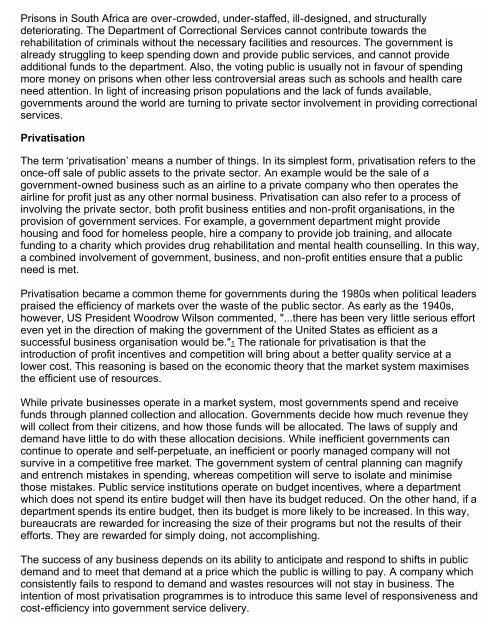prison privatisation in south africa issues, challenges and ...
prison privatisation in south africa issues, challenges and ...
prison privatisation in south africa issues, challenges and ...
Create successful ePaper yourself
Turn your PDF publications into a flip-book with our unique Google optimized e-Paper software.
Prisons <strong>in</strong> South Africa are over-crowded, under-staffed, ill-designed, <strong>and</strong> structurally<br />
deteriorat<strong>in</strong>g. The Department of Correctional Services cannot contribute towards the<br />
rehabilitation of crim<strong>in</strong>als without the necessary facilities <strong>and</strong> resources. The government is<br />
already struggl<strong>in</strong>g to keep spend<strong>in</strong>g down <strong>and</strong> provide public services, <strong>and</strong> cannot provide<br />
additional funds to the department. Also, the vot<strong>in</strong>g public is usually not <strong>in</strong> favour of spend<strong>in</strong>g<br />
more money on <strong>prison</strong>s when other less controversial areas such as schools <strong>and</strong> health care<br />
need attention. In light of <strong>in</strong>creas<strong>in</strong>g <strong>prison</strong> populations <strong>and</strong> the lack of funds available,<br />
governments around the world are turn<strong>in</strong>g to private sector <strong>in</strong>volvement <strong>in</strong> provid<strong>in</strong>g correctional<br />
services.<br />
Privatisation<br />
The term ‘<strong>privatisation</strong>’ means a number of th<strong>in</strong>gs. In its simplest form, <strong>privatisation</strong> refers to the<br />
once-off sale of public assets to the private sector. An example would be the sale of a<br />
government-owned bus<strong>in</strong>ess such as an airl<strong>in</strong>e to a private company who then operates the<br />
airl<strong>in</strong>e for profit just as any other normal bus<strong>in</strong>ess. Privatisation can also refer to a process of<br />
<strong>in</strong>volv<strong>in</strong>g the private sector, both profit bus<strong>in</strong>ess entities <strong>and</strong> non-profit organisations, <strong>in</strong> the<br />
provision of government services. For example, a government department might provide<br />
hous<strong>in</strong>g <strong>and</strong> food for homeless people, hire a company to provide job tra<strong>in</strong><strong>in</strong>g, <strong>and</strong> allocate<br />
fund<strong>in</strong>g to a charity which provides drug rehabilitation <strong>and</strong> mental health counsell<strong>in</strong>g. In this way,<br />
a comb<strong>in</strong>ed <strong>in</strong>volvement of government, bus<strong>in</strong>ess, <strong>and</strong> non-profit entities ensure that a public<br />
need is met.<br />
Privatisation became a common theme for governments dur<strong>in</strong>g the 1980s when political leaders<br />
praised the efficiency of markets over the waste of the public sector. As early as the 1940s,<br />
however, US President Woodrow Wilson commented, "...there has been very little serious effort<br />
even yet <strong>in</strong> the direction of mak<strong>in</strong>g the government of the United States as efficient as a<br />
successful bus<strong>in</strong>ess organisation would be."1 The rationale for <strong>privatisation</strong> is that the<br />
<strong>in</strong>troduction of profit <strong>in</strong>centives <strong>and</strong> competition will br<strong>in</strong>g about a better quality service at a<br />
lower cost. This reason<strong>in</strong>g is based on the economic theory that the market system maximises<br />
the efficient use of resources.<br />
While private bus<strong>in</strong>esses operate <strong>in</strong> a market system, most governments spend <strong>and</strong> receive<br />
funds through planned collection <strong>and</strong> allocation. Governments decide how much revenue they<br />
will collect from their citizens, <strong>and</strong> how those funds will be allocated. The laws of supply <strong>and</strong><br />
dem<strong>and</strong> have little to do with these allocation decisions. While <strong>in</strong>efficient governments can<br />
cont<strong>in</strong>ue to operate <strong>and</strong> self-perpetuate, an <strong>in</strong>efficient or poorly managed company will not<br />
survive <strong>in</strong> a competitive free market. The government system of central plann<strong>in</strong>g can magnify<br />
<strong>and</strong> entrench mistakes <strong>in</strong> spend<strong>in</strong>g, whereas competition will serve to isolate <strong>and</strong> m<strong>in</strong>imise<br />
those mistakes. Public service <strong>in</strong>stitutions operate on budget <strong>in</strong>centives, where a department<br />
which does not spend its entire budget will then have its budget reduced. On the other h<strong>and</strong>, if a<br />
department spends its entire budget, then its budget is more likely to be <strong>in</strong>creased. In this way,<br />
bureaucrats are rewarded for <strong>in</strong>creas<strong>in</strong>g the size of their programs but not the results of their<br />
efforts. They are rewarded for simply do<strong>in</strong>g, not accomplish<strong>in</strong>g.<br />
The success of any bus<strong>in</strong>ess depends on its ability to anticipate <strong>and</strong> respond to shifts <strong>in</strong> public<br />
dem<strong>and</strong> <strong>and</strong> to meet that dem<strong>and</strong> at a price which the public is will<strong>in</strong>g to pay. A company which<br />
consistently fails to respond to dem<strong>and</strong> <strong>and</strong> wastes resources will not stay <strong>in</strong> bus<strong>in</strong>ess. The<br />
<strong>in</strong>tention of most <strong>privatisation</strong> programmes is to <strong>in</strong>troduce this same level of responsiveness <strong>and</strong><br />
cost-efficiency <strong>in</strong>to government service delivery.
















